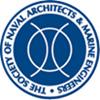Recent Developments in Computational Methods for the Analysis of Ducted Propellers in Open Water
IF 1
4区 工程技术
Q3 ENGINEERING, CIVIL
引用次数: 2
Abstract
This article presents an overview of the recent developments at Instituto Superior Técnico and Maritime Research Institute Netherlands in applying computational methods for the hydrodynamic analysis of ducted propellers. The developments focus on the propeller performance prediction in open water conditions using boundary element methods and Reynolds-averaged Navier-Stokes solvers. The article starts with an estimation of the numerical errors involved in both methods. Then, the different viscous mechanisms involved in the ducted propeller flow are discussed and numerical procedures for the potential flow solution proposed. Finally, the numerical predictions are compared with experimental measurements. Ducted propellers have been widely used for marine applications. Nowadays, they may be found in tugs, trawlers, tankers, bulk ships, warships, and in dynamic positioning systems of offshore platforms or vessels. The duct may be classified as an accelerating or decelerating type. Accelerating ducts are often used to increase the efficiency and thrust of heavily loaded propellers. In the case of a decelerating duct, they are used to reduce the risk of cavitation and resulting noise. The complex interaction which occurs between the propeller and duct makes the hydrodynamic design of such systems a complicated task. For the selection of the numerical simulation tool, the designer has to choose between a simplified method that predicts the main features of the flow field around the ducted propeller, and a more complex tool that provides detailed information in problematic areas such as the gap region between propeller and duct inner surface. On the other hand, model tests in a towing tank or cavitation tunnel may be seen as an alternative, but they are usually expensive. Presently, the development of an accurate and cost-effective numerical method for the design and analysis of ducted propellers is still not complete.开放水域中导管螺旋桨分析计算方法的最新进展
本文综述了荷兰苏尔寿tsamicnico研究所和荷兰海事研究所在应用计算方法进行导管螺旋桨水动力分析方面的最新进展。发展的重点是利用边界元方法和reynolds -average Navier-Stokes解算器预测开放水域条件下螺旋桨的性能。本文首先对两种方法所涉及的数值误差进行估计。在此基础上,讨论了导管式螺旋桨流动的不同粘性机制,并给出了势流解的数值计算方法。最后,将数值预测结果与实验结果进行了比较。导管螺旋桨在船舶上得到了广泛的应用。如今,它们可以在拖船、拖网渔船、油轮、散货船、军舰以及海上平台或船舶的动态定位系统中找到。风管可分为加速型和减速型。加速导管常用于提高重型螺旋桨的效率和推力。在减速管道的情况下,它们被用来减少空化的风险和由此产生的噪音。螺旋桨和风道之间复杂的相互作用使这类系统的水动力设计成为一项复杂的任务。对于数值模拟工具的选择,设计人员必须在预测导管螺旋桨周围流场主要特征的简化方法和提供螺旋桨与导管内表面间隙区域等问题区域详细信息的更复杂的工具之间进行选择。另一方面,在拖曳槽或空化隧道中进行模型试验可能被视为一种替代方法,但它们通常很昂贵。目前,对于导管式螺旋桨的设计和分析,一种准确、经济的数值方法的开发还不完善。
本文章由计算机程序翻译,如有差异,请以英文原文为准。
求助全文
约1分钟内获得全文
求助全文
来源期刊

Journal of Ship Research
工程技术-工程:海洋
CiteScore
2.80
自引率
0.00%
发文量
12
审稿时长
6 months
期刊介绍:
Original and Timely technical papers addressing problems of shipyard techniques and production of merchant and naval ships appear in this quarterly publication. Since its inception, the Journal of Ship Production and Design (formerly the Journal of Ship Production) has been a forum for peer-reviewed, professionally edited papers from academic and industry sources. As such, it has influenced the worldwide development of ship production engineering as a fully qualified professional discipline. The expanded scope seeks papers in additional areas, specifically ship design, including design for production, plus other marine technology topics, such as ship operations, shipping economic, and safety. Each issue contains a well-rounded selection of technical papers relevant to marine professionals.
 求助内容:
求助内容: 应助结果提醒方式:
应助结果提醒方式:


